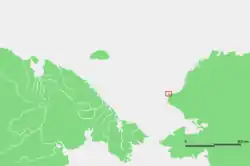Cape Lisburne, Alaska
Cape Lisburne is a cape located at the northwest point of the Lisburne Peninsula on the Chukchi Sea coast in Alaska. It is 40 miles (64 km) northeast of the village of Point Hope, part of the Arctic Slope. It is a part of the Chukchi Sea unit of Alaska Maritime National Wildlife Refuge.

The first European to sight this cape was James Cook. He named it on August 21, 1778 and wrote: "The southern extreme seemed to form a point which was named Cape Lisburne."
An early Inupiaq name for the cape was "Uivaq," generally spelled "Wevok" or "Wevuk". Cape Lisburne was often referred to as "Uivaq Ungasiktoq" meaning "distant cape" as opposed to "Uivaq Qanitoq" (Cape Thompson) meaning "near cape."

The native Inupiaq who lived there were struck by an deadly epidemic and many died along with an Episcopal missionary named John Driggs.[1] The missionary was buried in the middle of a field and the native people's bones lie in the same general area, many still exposed. The survivors fled to Point Hope. They return each summer to harvest eggs from the cliffs and caribou that migrate to the area but leave immediately after.
From 1951 to 1983, the United States Air Force maintained a long-range radar and communication facility at Cape Lisburne Air Force Station that was part of the DEW Line network of radar sites along the Alaska North Slope. The site was remediated in 2005.
References
- Lowenstein, T. (2010). Ultimate Americans: Point Hope, Alaska, 1826-1909. Fairbanks, AK: University of Alaska Press.
| Wikimedia Commons has media related to Cape Lisburne. |
- "Cape Lisburne". Geographic Names Information System. United States Geological Survey. Retrieved 2009-07-10.